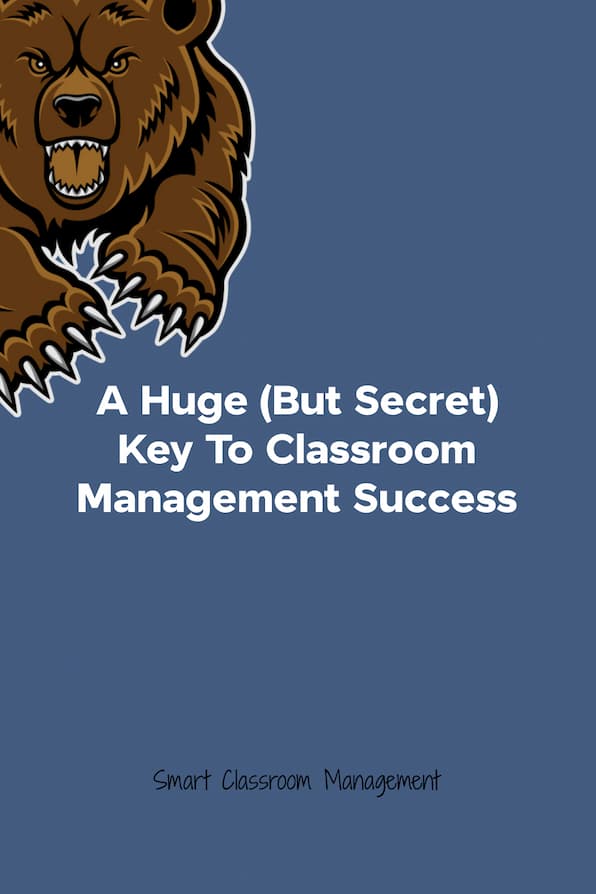
A Huge (But Secret) Key To Classroom Management Success

As part of my personal coaching practice I speak to a lot of teachers.
And although many of the classroom management struggles they need help with are diverse and unique to them, there are commonalities.
One such commonality is something they’re almost always unaware of. It’s a secret of sorts that I find myself sharing over and over again.
But it makes a huge, game-changing difference.
Today, I’d like to share it with you. It comes in the form of three steps that ensure that you and your students are pulling in the same direction.
1. Know what you want.
Most teachers don’t really know what they want and expect from their students from minute to minute, which means the students have to figure it out for themselves.
They have to fill in the gaps. Some will, and in a positive way, but many will not. Many will fill the lack of expectations with disruption, distraction, misbehavior, and the like.
The teacher, in turn, corrects and redirects again and again. It goes on like this all day long. It wastes time and is massively frustrating—for both the teacher and the students.
To fix it, you first must decide precisely what you want your students to be doing every moment of every day.
You must visualize in your mind’s eye how you want your students to pull out their laptops, for example, or clean their instruments or transition to another subject. Are they allowed to check their phones? Can they have drinks out? Can they whisper to a classmate?
They must know. Otherwise, there will always be trouble.
2. Teach it.
Once you’re clear on what you want, you must teach it to your students. You must be specific about what is and isn’t okay. It doesn’t matter whether you’re teaching kindergarten or high school.
Clarity is king. It allows students to relax and focus on the challenges and assignments you give them. It puts school on the forefront and allows for maximum efficiency.
The younger your students are, the more you need to model your expectations. What does beginning a writing assignment look like? What, exactly, do they do? Sit in a student’s seat and show them.
For older students you can often explain and model while standing in place, but only if you know for certain they understand. No matter the age, you have to check. You have to practice and/or observe closely to make sure it’s done right.
Details are essential, and they transfer to everything you do as a class. They raise the bar both academically and behaviorally. Details are also interesting to students.
Many teachers gloss over nearly everything in the false belief that students will get bored. The opposite is true. Specificity is good teaching. Fill in the gaps and transitions with explicit teaching of your expectations.
Your classroom will transform from a staccato, start-and-stop slog of frustration—with the time bear breathing down your neck—to a smooth and efficient bullet train.
3. Explain why.
Buy-in is so, so important but monstrously overlooked. You want your students to feel an urgency to fulfill your expectations correctly. This won’t happen if you stop after step two.
It may seem like a small thing, but this is the most important step.
You must explain why. Studies confirm that when you explain why—even if the why doesn’t make sense—your friends, family, and people around you are more likely to go along with your plans, ideas, and leadership decisions.
With students, however, I’ve found that when you can explain how your expectations are best for them, they become especially eager to follow along and do what you want.
Therefore, everything you do, every decision you make and expectation you set, must be indeed what is best for your students and their learning. And you must be able to explain why.
Purpose & Responsibility
Knowing what they are to do from opening bell to dismissal gives students a sense of purpose. It shifts responsibility from you, and having to narrate them and correct them through every this and that, to them, where they can feel empowered.
The more responsibility you can shift to your students the better. Always, always, always.
The weight on their shoulders, combined with you enforcing your classroom management plan if ever they stray from your expectations, is what changes behavior. It changes them as students and people.
Most students gad about without a care in the world, silly and unaware. Teachers on the other hand carry not only their own responsibilities but also those of their students.
This is why they’re so stressed and strung out. This is why their students are so ill behaved and seemingly mindless.
You must flip the script.
Only then will things begin to change.
PS – If you benefit from SCM, please share our articles with your friends, followers, and colleagues.
Also, if you haven’t done so already, please join us. It’s free! Click here and begin receiving classroom management articles like this one in your email box every week.
